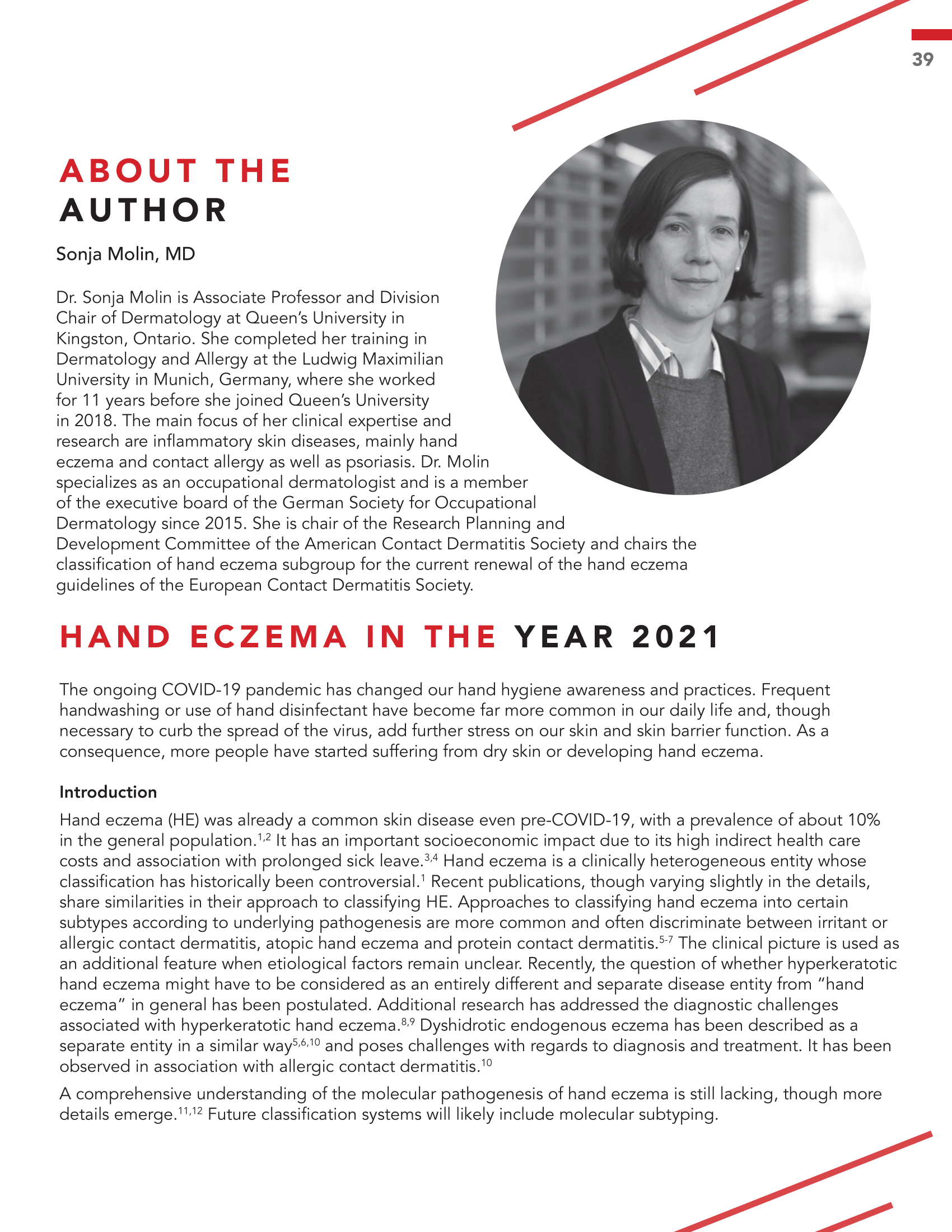Hand eczema in the year 2021
Abstract
Hand eczema (HE) was already a common skin disease even pre-COVID-19, with a prevalence of about 10% in the general population. It has an important socioeconomic impact due to its high indirect health care costs and association with prolonged sick leave. Hand eczema is a clinically heterogeneous entity whose classification has historically been controversial. Recent publications, though varying slightly in the details, share similarities in their approach to classifying HE. Approaches to classifying hand eczema into certain subtypes according to underlying pathogenesis are more common and often discriminate between irritant or allergic contact dermatitis, atopic hand eczema and protein contact dermatitis. The clinical picture is used as an additional feature when etiological factors remain unclear. Recently, the question of whether hyperkeratotic hand eczema might have to be considered as an entirely different and separate disease entity from “hand eczema” in general has been postulated. Additional research has addressed the diagnostic challenges associated with hyperkeratotic hand eczema. Dyshidrotic endogenous eczema has been described as a separate entity in a similar way and poses challenges with regards to diagnosis and treatment. It has been observed in association with allergic contact dermatitis.
References
Diepgen TL, Andersen KE, Chosidow O, et al. Guidelines for diagnosis, prevention and treatment of hand eczema. J Dtsch Dermatol Ges. 2015;13(1):e1-22.
Aviv H, Herzinger T, Molin S. Skin Barrier Dysfunction in Contact Dermatitis and Atopic Dermatitis-Treatment Implications. Current Treatment Options in Allergy. 2020;7(3):390-402.
Heede NG, Thuesen BH, Thyssen JP, et al. Hand eczema, atopic dermatitis and filaggrin mutations in adult Danes: a registry-based study assessing risk of disability pension. Contact Dermatitis. 2017;77(2):95-105.
Coenraads PJ. Hand eczema. The New England journal of medicine. 2012;367(19):1829-1837.
Diepgen TL, Andersen KE, Brandao FM, et al. Hand eczema classification: a cross-sectional, multicentre study of the aetiology and morphology of hand eczema. Br J Dermatol. 2009;160(2):353-358.
Agner T, Aalto-Korte K, Andersen KE, et al. Classification of hand eczema. J Eur Acad Dermatol Venereol. 2015;29(12):2417-2422.
Menne T, Johansen JD, Sommerlund M, Veien NK, Danish Contact Dermatitis G. Hand eczema guidelines based on the Danish guidelines for the diagnosis and treatment of hand eczema. Contact Dermatitis. 2011;65(1):3-12.
Van Der Heiden J, Agner T, Rustemeyer T, Clemmensen KKB. Hyperkeratotic hand eczema compared to other subgroups of hand eczema–a retrospective study with a follow-up questionnaire. Contact Dermatitis. 2018;78(3):216-222.
Politiek K, Loman L, Pas HH, et al. Hyperkeratotic hand eczema: Eczema or not? Contact Dermatitis. 2020.
Johansen JD, Hald M, Andersen BL, et al. Classification of hand eczema: clinical and aetiological types. Based on the guideline of the Danish Contact Dermatitis Group. Contact Dermatitis. 2011;65(1):13-21.
Tauber M, Bérard E, Lourari S, et al. Latent class analysis categorizes chronic hand eczema patients according to skin barrier impairment. J Eur Acad Dermatol Venereol. 2019.
Molin S, Merl J, Dietrich KA, et al. The hand eczema proteome: imbalance of epidermal barrier proteins. Br J Dermatol. 2015;172(4):994-1001.
Molin S. [Pathogenesis of hand eczema]. Hautarzt. 2019;70(10):755-759.
Gronhagen C, Liden C, Wahlgren CF, et al. Hand eczema and atopic dermatitis in adolescents: a prospective cohort study from the BAMSE project. The British journal of dermatology. 2015;173(5):1175-1182.
Simonsen AB, Ruge IF, Quaade AS, Johansen JD, Thyssen JP, Zachariae C. High incidence of hand eczema in Danish schoolchildren following intensive hand hygiene during the COVID-19 pandemic: a nationwide questionnaire study. Br J Dermatol. 2020;183(5):975-976.
Simonsen AB, Ruge IF, Quaade AS, Johansen JD, Thyssen JP, Zachariae C. Increased occurrence of hand eczema in young children following the Danish hand hygiene recommendations during the COVID-19 pandemic. Contact Dermatitis. 2020.
Candi E, Schmidt R, Melino G. The cornified envelope: a model of cell death in the skin. Nature reviews Molecular cell biology. 2005;6(4):328-340.
Gimenez-Arnau A. Standards for the Protection of Skin Barrier Function. Current problems in dermatology. 2016;49:123-134.
Egawa G, Kabashima K. Multifactorial skin barrier deficiency and atopic dermatitis: Essential topics to prevent the atopic march. The Journal of allergy and clinical immunology. 2016;138(2):350-358.
Thyssen JP, McFadden JP, Kimber I. The multiple factors affecting the association between atopic dermatitis and contact sensitization. Allergy. 2014;69(1):28-36.
Smith HR, Basketter DA, McFadden JP. Irritant dermatitis, irritancy and its role in allergic contact dermatitis. Clin Exp Dermatol. 2002;27(2):138-146.
Heede NG, Thyssen JP, Thuesen BH, Linneberg A, Johansen JD. Predictive factors of self-reported hand eczema in adult Danes: a population-based cohort study with 5-year follow-up. Br J Dermatol. 2016;175(2):287-295.
Elhaji Y, Sasseville D, Pratt M, et al. Filaggrin gene loss-of-function mutations constitute a factor in patients with multiple contact allergies. Contact Dermatitis. 2019;80(6):354-358.
Ali SM, Yosipovitch G. Skin pH: from basic science to basic skin care. Acta Derm Venereol. 2013;93(3):261-267.
Jungersted JM, Hogh JK, Hellgren LI, Jemec GB, Agner T. Skin barrier response to occlusion of healthy and irritated skin: differences in trans-epidermal water loss, erythema and stratum corneum lipids. Contact dermatitis. 2010;63(6):313-319.
Thyssen JP, Linneberg A, Menne T, Johansen JD. The epidemiology of contact allergy in the general population–prevalence and main findings. Contact dermatitis. 2007;57(5):287-299.
Friedmann PS, Sanchez-Elsner T, Schnuch A. Genetic factors in susceptibility to contact sensitivity. Contact dermatitis. 2015;72(5):263-274.
Rundle CW, Presley CL, Militello M, et al. Hand hygiene during COVID-19: Recommendations from the American Contact Dermatitis Society. J Am Acad Dermatol. 2020;83(6):1730-1737.
Meckfessel MH, Brandt S. The structure, function, and importance of ceramides in skin and their use as therapeutic agents in skin-care products. Journal of the American Academy of Dermatology. 2014;71(1):177-184.
Mostosi C, Simonart T. Effectiveness of Barrier Creams against Irritant Contact Dermatitis. Dermatology (Basel, Switzerland). 2016;232(3):353-362.
Jordan L. Efficacy of a Hand Regimen in Skin Barrier Protection in Individuals With Occupational Irritant Contact Dermatitis. Journal of drugs in dermatology: JDD. 2016;15(11):s81-s85.


